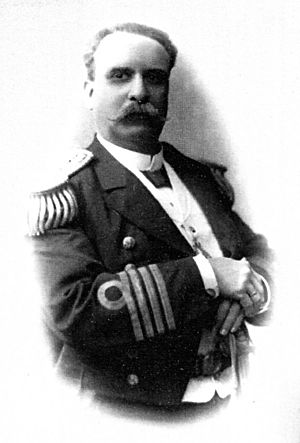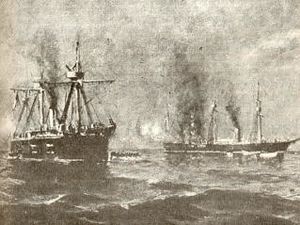Peruvian gunboat Pilcomayo facts for kids

Pilcomayo
|
|
Quick facts for kids History |
|
|---|---|
| Name | Pilcomayo |
| Ordered | March 1872 |
| Builder | Money Wigram and Sons, Blackwall, England |
| Laid down | 1873 |
| Launched | 1874 |
| Commissioned | 1874 |
| Captured | Captured by Chile at the Tocopilla, 18 November 1879 |
| Decommissioned | 1909 |
| General characteristics | |
| Type | corvette |
| Displacement | 600 long tons (610 t) |
| Length | 52.12 m (171 ft 0 in) |
| Beam | 8.35 m (27 ft 5 in) |
| Draught | 3.35 m (11 ft 0 in) |
| Installed power | 1080 HP at 10,0 knots |
| Propulsion |
|
| Sail plan | Three masts Barque square-rigged |
| Speed | 115 knots (213 km/h; 132 mph) |
| Range | 1836 nmiles at 9,0 knots |
| Complement | 130 |
| Armament |
|
The Pilcomayo was a gunboat from Peru. It was involved in many battles during the War of the Pacific. On November 18, 1879, the Chilean navy captured it. After being fixed, it helped block Peruvian ports. Later, it was used for mapping the sea and training new sailors. The ship served until 1909. Finally, it became a floating dock in Talcahuano.
Contents
Ship Design and Features
The Pilcomayo had a strong hull made of teak wood. Its bottom was covered in copper. It also had strong metal supports inside. The ship had a powerful engine built by J. Penn & Company. This engine gave it a top speed of 11.5 knots. This was measured on August 7, 1874.
The Pilcomayo was armed with six guns.
- Two large 70-pound Armstrong guns. One was on the right side, and one on the left.
- Four smaller 40-pound Armstrong guns. Two were on each side.
- A Gatling gun was added just before the war started.
Building the Pilcomayo
The Peruvian government planned to buy two large armored ships and two gunboats. They set aside money for this. However, only the two gunboats were bought. These ships were the Chanchamayo and the Pilcomayo.
They were built in England between 1872 and 1874. The shipyard was Money Wigram in Blackwall. Both ships arrived in Callao, Peru, on January 11, 1875.
The Pilcomayo was almost named Putumayo. This name came from a river in Peru. But the ship's painter made a mistake. He confused it with another gunboat called Pilcomayo. That ship was being built for Argentina at the same time.
In 1877, the Pilcomayo joined a group of ships. Their mission was to find the rebel armored ship Huáscar.
During the War of the Pacific, the Pilcomayo was very active.
- On April 7, 1879, it left Callao with the corvette Union.
- It took part in the battle of Chipana.
- Captain Antonio C. de la Guerra was in charge of the Pilcomayo then.
- The ship returned to Callao on April 17.
Trips to Bolivia and Chile
The Pilcomayo was sent out again on June 29, 1879. This time, Captain Carlos Ferreyros was its commander.
- It sailed from Callao and reached Arica on July 2.
- It carried 2,000 rifles for the Bolivian army.
- On July 4, it protected the transport ship Oroya to Pisagua.
- Then, it continued its journey south.
Action at Tocopilla
Captain Carlos Ferreyros headed for Tocopilla.
- On July 6, at 9:00 AM, the Pilcomayo entered Tocopilla. It sailed past Chilean warships in the dark.
- In the port, it found a Chilean merchant ship named "Matilde." It also found three other boats. These boats were full of food and supplies.
- Captain Ferreyros sent a message to the townspeople. He promised not to attack the town.
- Then, he sank the "Matilde" with five cannon shots. He also destroyed the other boats.
Chased by Chilean Warships
After Tocopilla, Commander Ferreyros ordered the ship to go fast towards Antofagasta. He hoped to surprise the Chilean army camp there.
- But at 12:20 PM, he saw the Chilean armored ship Chilean ironclad Blanco Encalada.
- The Blanco Encalada was with the corvette Chacabuco and the transport ship Limarí.
- These Chilean ships were coming from Iquique. They had just attacked Pabellón de Pica.
When Ferreyros saw the Chilean ships, he steered close to the coast. He wanted to escape. Then, he sped north. The Blanco Encalada chased the Pilcomayo for almost 20 hours. The Pilcomayo reached Arica on July 8 at 3:00 AM. The Chilean ships stopped their chase.
More Encounters
On July 15, the Pilcomayo was ordered to Cobija. It was supposed to capture enemy transport ships. They thought the Chilean armored ship Almirante Cochrane was in Iquique. They also thought the Blanco Encalada was in Antofagasta.
- But on the way, the Pilcomayo met the Cochrane and the Chacabuco. They were sailing from Iquique to Antofagasta.
- The Cochrane chased the Pilcomayo between July 17 and 18. But it could not catch it.
- The Pilcomayo arrived in Arica on July 22.
- After a short trip near Pacocha, it returned to Callao on July 26. It carried 28 prisoners from a captured transport ship called Rímac.
Other Actions
On August 23, the Pilcomayo left Callao. It was protecting the transport ship Chalaco. They arrived at Arica on August 26.
- On September 13, near Arica, it met the Blanco Encalada. This ship was carrying Rafael Sotomayor, the Chilean War Minister.
- It also met the artillery transport Itata, commanded by Patricio Lynch. They were looking for places to land for a planned Chilean invasion.
- The Pilcomayo fired 10 shots at them. It tried to start a fight.
- But the Chilean ships kept their distance. The Itata fired 6 shots back.
On October 5, a Chilean fleet arrived in Arica.
- At 9:30 AM, the Pilcomayo sailed out to face them. This was ordered by President Mariano Ignacio Prado.
- At 10:00 AM, the Pilcomayo met the Chilean ships.
- The gunboat Covadonga and the corvette O'Higgins separated from the Chilean group.
- A fight happened between the Pilcomayo and the O'Higgins. It was 6 miles from Arica, between 10:30 and 11:30 AM.
- The Pilcomayo fired 21 shots. The O'Higgins fired 16 shots.
The Capture of the Pilcomayo
On November 18, 1879, around 9:00 AM, the Chilean armored ship Blanco Encalada was near Mollendo. It saw three columns of smoke to the south. These were from the Peruvian corvette Union, the transport Chalaco, and the Pilcomayo.
The Union was leading the Peruvian ships. It saw the Blanco Encalada and turned south to warn the others. The Peruvian commanders decided on a plan. The Union would try to lure the Blanco Encalada away. The Union was faster, so it could escape. This would save the other two ships from being captured.
- So, the Union headed west slowly.
- The Pilcomayo sailed south at full speed.
- The "Chalaco" changed its direction to the southeast, staying close to the coast.
On the Blanco Encalada, Chilean commander Galvarino Riveros knew how fast the Peruvian ships were. He did not fall for the trick. He decided to chase the Pilcomayo at full speed.
The Commander of the Pilcomayo realized the Blanco Encalada was catching up fast. He gathered his officers. They agreed to sink their ship rather than surrender it. They kept sailing away to gain time to carry out this plan.
When the Blanco Encalada was 5,000 meters away, the Pilcomayo opened fire. But it did not hit its target. The Chilean ship did not fire back until it was 4,200 meters away. Its shot hit the Pilcomayo's front mast.
- At this point, Commander Ferreyros opened valves to let water into the engine room and the ammunition storage.
- He ordered flammable materials to be spread out to set the ship on fire.
- The back guns were aimed at a hatch to make holes below the waterline.
- Then, he ordered all secret codes, letters, and documents on the ship to be destroyed.
The fire was started. The ship stopped. Boats were lowered to take the crew off the ship. Chilean Admiral Riveros saw white flags raised on the boats. He ordered his ship to stop firing and stop its engines. Lieutenant Roberto Goñi then boarded the Peruvian ship.
Once on board, Goñi took down the Peruvian flag and put up the Chilean flag. He did everything he could to save the ship. He tied it to the Blanco Encalada. The Chilean ship's pumps helped keep the Pilcomayo from sinking. The Chilean crew put out the fires. In two hours, divers had sealed the leaks, and the fires were out.
The Chileans towed the Pilcomayo to the port of Pisagua. They arrived on November 20. The Peruvian prisoners were taken ashore. Then, the Pilcomayo was taken to Valparaíso. They arrived there on December 4. The people were very happy and filled the streets to celebrate the victorious sailors. The Pilcomayo stayed in Valparaiso for repairs.
Later Life of the Ship
After the War of the Pacific, the Pilcomayo was used for mapping the sea. It also served as a training ship for young naval officers.
During the Chilean Civil War of 1891, the ship stayed in Buenos Aires.
The Pilcomayo served the Chilean Navy until 1909. After that, it was turned into a floating dock in Talcahuano.




